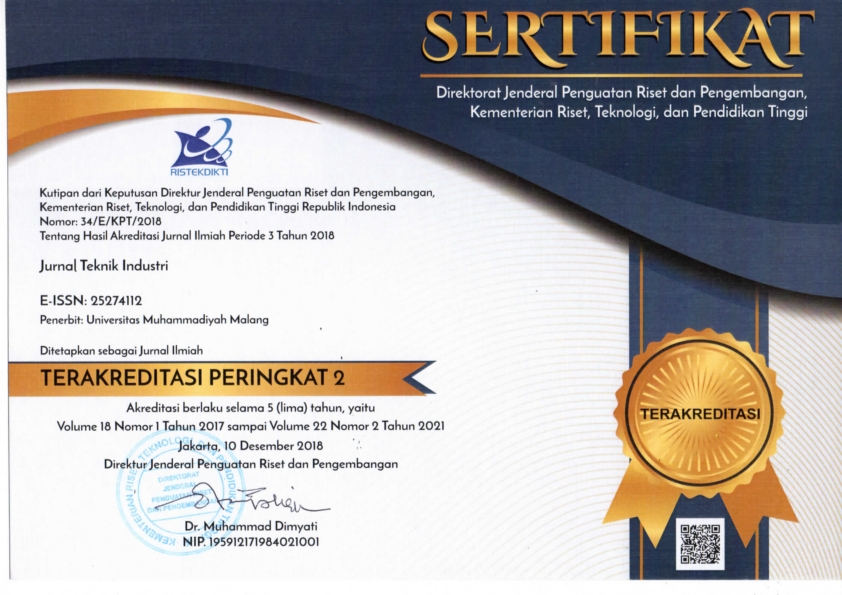Analysis of the Effect of Occupational Safety and Health (OSH) Culture on Implementing OSH Awareness: A Case Study
DOI:
https://doi.org/10.22219/JTIUMM.Vol23.No1.17-30Keywords:
OSH Culture, Occupational Safety and Health, IE Student of UMS, PLS-SEMAbstract
Occupational Safety and Health (OSH) culture among students has not become a full awareness that is applied in everyday life in college. This study aims to identify, test, and analyze how much OSH culture influences implementing OSH awareness for students. The research was conducted on Industrial Engineering students at Universitas Muhammadiyah Surakarta (IE UMS) as many as 120 respondents from the class of 2016 to 2019 filled out a questionnaire about OSH culture. The method used in this study is the analysis approach of Structural Equation Modeling (SEM) variance-based or so-called Partial Least Square (PLS-SEM). The variables in the OSH culture are four independent variables, namely: individual, organizational, occupational, and environmental with 18 sub-variables. Meanwhile, one dependent variable, awareness, consists of six sub-dependent variables. It was found that environmental, organizational, and occupational factors on awareness level significantly affect implementing OSH culture, and individual factors have no significant effect on the awareness level of implementing OSH culture. Thus, an improvement strategy is obtained by increasing environmental, organizational, and occupational preferences to maximize the implementation of OSH culture.
Downloads
References
Y. Gong, "Safety culture among Chinese undergraduates: A survey at a university," Safety Science, vol. 111, pp. 17-21, 2019. https://doi.org/10.1016/j.ssci.2018.09.010.
Y. Kim, J. Park, and M. Park, "Creating a Culture of Prevention in Occupational Safety and Health Practice," Safety and Health at Work, vol. 7, no. 2, pp. 89-96, 2016. https://doi.org/10.1016/j.shaw.2016.02.002.
M. D. Cooper, "The Safety Culture Construct: Theory and Practice," in Safety Cultures, Safety Models: Taking Stock and Moving Forward, C. Gilbert, B. Journé, H. Laroche, and C. Bieder, Eds. Cham: Springer International Publishing, 2018, pp. 47-61, doi: https://doi.org/10.1007/978-3-319-95129-4_5.
M. D. Cooper Ph.D, "Towards a model of safety culture," Safety Science, vol. 36, no. 2, pp. 111-136, 2000. https://doi.org/10.1016/S0925-7535(00)00035-7.
T. W. Reader, M. C. Noort, S. Shorrock, and B. Kirwan, "Safety sans Frontières: An International Safety Culture Model," Risk Analysis, vol. 35, no. 5, pp. 770-789, 2015. https://doi.org/10.1111/risa.12327.
A. M. Bjerkan, "Health, environment, safety culture and climate – analysing the relationships to occupational accidents," Journal of Risk Research, vol. 13, no. 4, pp. 445-477, 2010. https://doi.org/10.1080/13669870903346386.
S. Liu, E. Gyabeng, G. Joshua Atteh Sewu, N. K. Nkrumah, and B. Dartey, "Occupational Health and Safety and Turnover Intention in the Ghanaian Power Industry: The Mediating Effect of Organizational Commitment," BioMed Research International, vol. 2019, p. 3273045, 2019. https://doi.org/10.1155/2019/3273045.
E. Bethel, C. Ogechi, and M. D. Tamunomiebi, "Safety Management and Job Performance among Employees in Manufacturing Firms in Rivers State, Nigeria," 2019, vol. 7, no. 2, pp. 112-122.
J. C. Westland, Structural Equation Models: From Paths to Networks, 1 ed. (Studies in Systems, Decision and Control). Springer Nature, 2020, pp. IX, 175.
H.-T. Huang, C.-H. Tsai, and C.-F. Wang, "A Model for Promoting Occupational Safety and Health in Taiwan’s Hospitals: An Integrative Approach," Journal, Type of Article vol. 16, no. 5, 2019. https://doi.org/10.3390/ijerph16050882.
H. Ravand and P. Baghaei, "Partial least squares structural equation modeling with R," Practical Assessment, Research, and Evaluation, vol. 21, no. 1, p. 11, 2016. https://doi.org/10.7275/d2fa-qv48.
C. Subramaniam, F. M. Shamsudin, and A. S. I. Alshuaibi, "Investigating Employee Perceptions Of Workplace Safety And Safety Compliance Using Pls-Sem Among Technical Employees In Malaysia," in Journal of Applied Structural Equation Modeling, 2017, vol. 1, no. 1, pp. 44-61. https://doi.org/10.47263/JASEM.1(1)05.
M. H. Binsawad, "Corporate Social Responsibility in Higher Education: A PLS-SEM Neural Network Approach," IEEE Access, vol. 8, pp. 29125-29131, 2020. https://doi.org/10.1109/ACCESS.2020.2972225.
K. K.-K. Wong, "Partial least square structural equation modeling (PLS-SEM) techniques using SmartPLS," Marketing Bulletin, vol. 24, no. 1, pp. 1-32, 2013.
M. D. Cooper, M. Collins, R. Bernard, S. Schwann, and R. J. Knox, "Criterion-related validity of the cultural web when assessing safety culture," Safety Science, vol. 111, pp. 49-66, 2019. https://doi.org/10.1016/j.ssci.2018.09.013.
V. D. Supartini and A. Sukmawati, "Building an Occupational Safety Behavior in an Organization," Binus Business Review, vol. 10, no. 2, pp. 113-118, 2019. https://doi.org/10.21512/bbr.v10i2.5586.
E. A. Nadhim, C. Hon, B. Xia, I. Stewart, and D. Fang, "Investigating the relationships between safety climate and safety performance indicators in retrofitting works," (in English), Construction Economics and Building, Other Journal Article vol. 18, no. 2, pp. 110-129, 2018. https://doi.org/10.5130/AJCEB.v18i2.5994.
K. Wong, "TECHNICAL NOTE: Mediation analysis, categorical moderation analysis, and higher-order constructs modeling in Partial Least Squares Structural Equation Modeling (PLS-SEM): A B2B Example using SmartPLS," The Marketing Bulletin, vol. 26, no. 1, pp. 1-22, 2016.
C. Fornell and D. F. Larcker, "Evaluating Structural Equation Models with Unobservable Variables and Measurement Error," Journal of Marketing Research, vol. 18, no. 1, pp. 39-50, 1981. https://doi.org/10.1177/002224378101800104.
K. J. Nielsen, "Improving safety culture through the health and safety organization: A case study," Journal of Safety Research, vol. 48, pp. 7-17, 2014. https://doi.org/10.1016/j.jsr.2013.10.003.
U. Yudatama, A. N. Hidayanto, B. A. A. Nazief, and K. Phusavat, "Data to model the effect of awareness on the success of IT Governance implementation: A partial least squares structural equation modeling approach (PLS-SEM)," Data in Brief, vol. 25, p. 104333, 2019. https://doi.org/10.1016/j.dib.2019.104333.
W. W. Chin, "Commentary: Issues and Opinion on Structural Equation Modeling," MIS Quarterly, vol. 22, no. 1, pp. vii-xvi, 1998.
T.-S. Su, P.-R. Lin, Y.-L. Shu, J.-M. Tseng, and C.-S. Kao, "Analysis of the Multi-Relationships and Their Structures for Safety Culture %J Open Journal of Safety Science and Technology," vol. 2, no. 3, pp. 89-97, 2012. https://doi.org/10.4236/ojsst.2012.23012.
R. Kaynak, A. T. Toklu, M. Elci, and I. T. Toklu, "Effects of occupational health and safety practices on organizational commitment, work alienation, and job performance: Using the PLS-SEM approach," International Journal of Business and Management, vol. 11, no. 5, pp. 146-166, 2016. http://dx.doi.org/10.5539/ijbm.v11n5p146.
Downloads
Published
How to Cite
Issue
Section
License
Copyright (c) 2022 Indah Pratiwi and Yusakh Ivanovic

This work is licensed under a Creative Commons Attribution-ShareAlike 4.0 International License.











